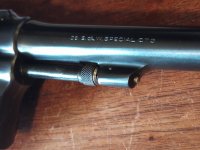I had some old Pre War K-Frame revolvers, and I noticed that the ends of the ejector rods looked like they were "polished" or just "In the white"... but they had been used heavily, I thought it was just "Wear'... Now I have obtained a postwar K-Frame that was practical new-in-box, and I notice the same type of wear on the end of the ejector rod... was that how they left the factory????
Thanks
That isn't wear, that is how they were finished at the factory. The bevel was polished (used to be) and the end was the result of fitting for length. It is the
extractor and
extractor rod, revolvers do not have ejectors, automatics and long guns do.
I like Lee, and he is usually correct, but there are several parts that must be "fit", not just what he lists.
The sideplate requires fitting. If you look closely at the edge there are obvious file marks usually. that is why this part has the "assembly number" stamped on the inside, as does the yoke. Sideplates will not interchange between frames The extractor rod does need to be fit, but it can be a slight amount short. If too long the extractor rod snags on the "locking bolt", the beveled plunger in the barrel lug that engages the front of the extractor rod. Sometimes drop-in, but often must be fit by shortening just a few thousandths until the front end of the center pin is just
above flush. Just about every extractor rod I have ever replaced had to be fit a small amount.
There are other parts that
may have to be fit too. Of course the stocks were fit to the individual frame too, that is why the serial number is (was) stamped inside the right stock. The stocks were fit in the "stock job" when made, not done by the "fitter" who "puts-up" (assembles) the revolver.
The more recent guns do need less individual fitting than guns made before the 1980s.

